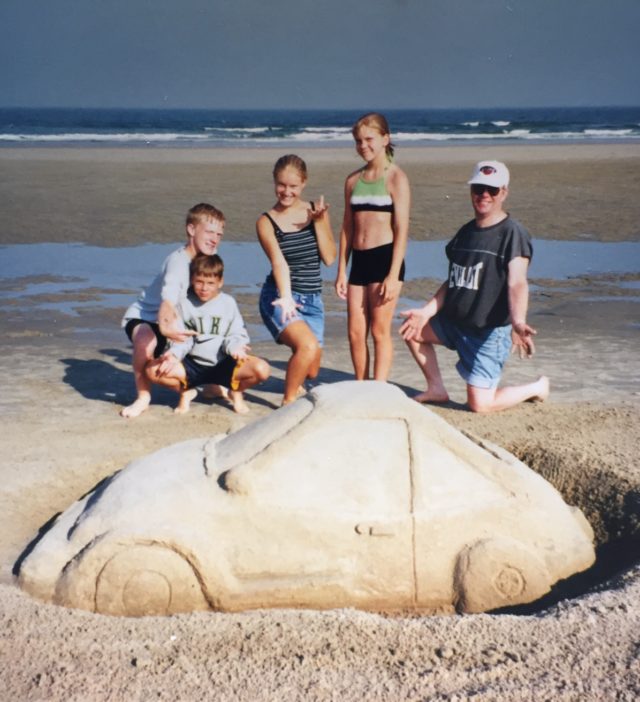It’s getting to that time of year when the beach becomes a favorite past time. If you’ve ever been to the beach, you’ve probably seen a diverse range of sand sculptures: castles, sea urchins, animals, fish, and many other interesting things. A few will be masterfully done, others considered decent and some won’t be much to look at. I have found the outcome doesn’t really matter because none can withstand the crushing tide; yet the next day people return to build other “art forms” that will inevitably be expunged again. Why do they do this? For one, it’s fun, and secondly, there’s no pressure to succeed. It’s simply an opportunity to be creative without worrying whether or not it’s good enough because it won’t stand long enough to make a difference. When my children were younger, they liked to build sand walls around their castles to see which one will stand the longest, but in the end, all sculptures perish; even the biggest wall of sand cannot hold back the tide.
As the waves crash in and wash the sand smooth, it becomes an irresistible medium for creativity. Some find a freedom with sand that they cannot find on canvas or paper; these surfaces seem more intimidating because they carry with them a sense of permanence. Whether we write, draw, paint, or scrapbook, the results will be in front of us as a reminder of how bad we think we are. Unfortunately, this keeps some from ever getting started with a creative outlet. If you learn nothing else from lessons in the sand, please take to heart that paper, canvas, or any other medium for that matter, can be hidden, ripped up, scribbled over, thrown out, and even burned… just as quickly as the sand can be obliterated when the results don’t meet with our expectations. Pen, paper, paint, or canvas are not our enemies, or something to fear because of their lasting qualities; they are simply the means to an end. If the result of our efforts is not worthy by our standards, we must be willing to set it aside or throw it away and start anew. Creative skills increase with practice and, with practice, improvements are inevitable.
The need for perfection is like driving through life with the emergency brake on, often causing unnecessary damage. Desiring to succeed is one thing, but the unrelenting constraint of striving for excellence sometimes holds back true ability from expressing itself. Just today, a seven-year-old boy told me he does really well at tee-ball when his dad’s not there. It’s sad when anxiety starts at such a young age and yet so many carry this kind of mind-set with them through life. When the pressure is off, we naturally do better. It’s as if the intimidation factor disappears and confidence gains momentum, allowing our talents to develop at an appropriate pace.
Sand is not daunting because it has no lasting power and leaves no memory of any sculpture, whether it was perfect or not. If the tide doesn’t come in soon enough to wipe out a mistake or a poor design, it can easily be trampled underfoot. Because of this, ample creative energy goes into this artistic endeavor. While working with sand, stress and restraint don’t seem relevant. Even people who don’t feel artistically inclined can join in and have a good time because there are no lasting expectations… just creative fun.
Another great motivator of sand art is that you can keep adding to it; there are no limitations. Once, we shaped two dolphins coming up out of the water, gracefully tipping their heads, looking majestic as dolphins often do. We added some waves around them and thought we were done. Then our son Stephen, who wasn’t tired of it yet, started heaping sand up a short distance behind the dolphins. When we asked what he was doing, he only replied, “You will have to wait and see.” As our curiosity peaked, up out of the sand came “Jaws” pursuing the dolphins. How it changed the whole mood by adding suspense. It was a creative moment we all enjoyed.
Sand art not only brings pleasure to the one creating it, it captures the attention of those passing by. One of the most gratifying moments after hours of digging and shaping sand is to have admirers pause to look at what we’ve made. Some look quickly and move on, while others stop, taking the time to appreciate our handiwork and strike up a conversation.
Once, our family spent hours sculpting a large lion with a huge mane. It was late in the day when we finished and the beach was clearing, except for those who were out for an evening walk. Many stopped to look and commented on a “job well done.” After a bit, we moved away from the lion to watch from a distance how people would respond as they passed. Just about every person that went by stopped to look more closely and most of their expressions reflected some kind of contemplation. We couldn’t tell what they were thinking, nor did it matter. The important result was a visual experience worth the pause in their walk along the beach.

